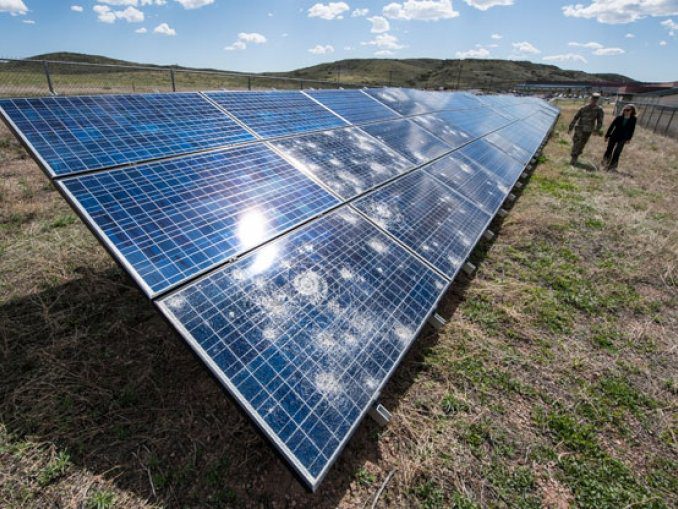Evolving Extreme Weather Risks Posing Unprecedented Insurance Woes for Renewables
Credit to Author: Sonal Patel| Date: Tue, 18 Oct 2022 14:34:57 +0000

Unexpectedly steep financial losses suffered by the U.S. renewables market owing to a barrage of extreme weather events over the past summer suggest that project hardening strategies aren’t going far enough, a major renewables insurer is warning.
GCube, an international insurer for wind, solar, wave, hydro, and tidal projects around the world in an update on Oct. 18 said the U.S. renewables market “just experienced its worst summer on record” for natural catastrophe claims. Financial impacts from these weather-related events have been exacerbated by the sector’s ongoing vulnerability to supply chain challenges, “with significant financial implications tied to increased downtime and component costs,” the group said.
“While total claims values are still being calculated, multiple instances of losses exceeding sub-limits of up to $50 million, due to extreme weather events like hail, tornados, and derechos, make clear the need for improved modeling and the more effective use of existing weather data,” it warned.
Unprecedented but Not Unexpected
The group’s concerns stem from a trend of “large-scale” damages suffered by the North American renewable energy sector in recent years, owing to some of the most destructive extreme weather events “in living memory.” It’s clear, GCube said, that natural catastrophes and extreme weather events “are on the rise.”
“While the increasing frequency of extreme weather and [natural catastrophe] events is not surprising to us, the rising severity of losses, and the industry’s continued difficulty in managing these risks, is a concerning trend,” said Fraser McLachlan, GCube’s CEO. “The unprecedented growth potential unlocked by the Inflation Reduction Act will count for little if the North American renewables sector is unable to combat extreme weather risks.”
In its Tuesday-released North American Nat Cat Update, GCube, a member of the Tokio Marine HCC group, noted that insured property losses due to natural disasters have been on the rise across all industries, surging to $92 billion in 2021 from $74 billion in 2020. Recent losses in the renewables sector suggest that unmodeled events continue to outpace modeled natural catastrophe events in terms of frequency. Over the last three years, the insurance industry has recorded 40 severe storms—encompassing high winds, hail, tornadoes, and derechos—compared to 13 traditional windstorm events, such as hurricanes, it said.
A surge in hail and rainstorm losses has grown into a specific concern owing to its pronounced impact on the solar industry. GCube’s report suggests, for example, that hail losses in Texas early this summer resulted in estimated solar damage of more than $300 million—more than twice as severe as other key renewable losses over the last three years combined. “Multiple solar losses are reported to have exceeded sub-limits of up to $50 million as a result of [natural catastrophe] events over the last two to three years, while tornado losses in some cases are reported to match the anticipated value of damages from Hurricane Hanna,” the report says.

Solar’s Notable Vulnerabilities
Solar appears to be especially vulnerable to losses because of the sector’s increased exposure to natural catastrophe risks. GCube’s report suggests that “developments of solar technology are behind the curve when it comes to improving weather resistance.” A key issue stems from testing whose minimum requirements are easy to pass. “The International Electrotechnical Commission’s (IEC’s) hail tests utilize projectiles of 25 [milimeters], which are half the size of the average hailstone experienced in the ‘very severe’ hailstorms we are seeing more frequently across the continent,” the report says. “Meanwhile, there remains no requirement to test for micro-cracking, a key issue which causes considerable issues for insurers,” it adds.
That is in “sharp contrast” to wind turbine testing, which targets scale, strength, and weather-proofing against severe events like typhoons, it said. The solar industry, meanwhile, has been moving toward adopting thinner panes of glass to reduce raw materials required for construction, but that is a trend that could hamper panel resilience to weather events. Clearly, original equipment manufacturers “need to consider their accountability for developing solar technologies that can withstand severe weather trends,” it adds. “Solar has some catching up to do.”
GCube’s McLachlan said a more adequate market correction will be needed to address the growing severity of natural catastrophes and extreme weather events, given that a softening of rates could jeopardize the sustainable growth of U.S. wind and solar. GCube urges project owners to work with insurers to revise sub-limits regularly, using the latest understanding of risks, to ensure that assets will be appropriately covered in the event of a claim.
“Concerted effort is needed across the value chain to strengthen policies, improve data utilization, and update modeling and testing procedures, and support sustainable growth for the sector,” McLachlan said. “Our latest report issues a clear call for collaboration in the U.S. renewables industry to develop measures to combat the fallout of extreme weather, and support a stable, successful energy transition.”
—Sonal Patel is a POWER senior associate editor (@sonalcpatel, @POWERmagazine).
The post Evolving Extreme Weather Risks Posing Unprecedented Insurance Woes for Renewables appeared first on POWER Magazine.